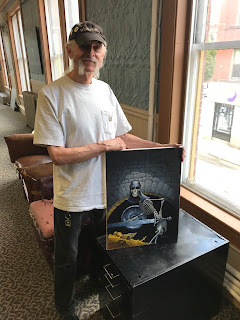Equating sword-and-sorcery with Robert E. Howard, and Howard
alone, is an easy path to start down, and a tempting one to follow to the end. One
I had to be mindful of, and consciously revise my line of thinking many times,
while writing Flame and Crimson.
How do you define a genre that nearly everyone agrees Howard
created, and not just default to Howard = S&S?
If S&S is only Howard, and defined only by what he
wrote, then it’s not a genre. It’s the works of a single man. Howard created
sword-and-sorcery in the 1920s, but he did not consciously set out to do so. He
was trying to tell entertaining stories of blood and thunder, and make a
living. When he died in 1936 there were very few indications sword-and-sorcery
would survive, let alone flourish. It had a lot more growing to do.
That got underway in earnest in 1939 when Fritz Leiber’s “Two
Sought Adventure” appeared in Unknown.
Leiber proved that sword-and-sorcery could be witty, and ironic, have different
thematic concerns, and not take itself so seriously.
Heck, sword-and-sorcery was evolving during Howard’s lifetime. Leiber had conceived of Fafhrd and the
Gray Mouser as far back as 1934 with significant input from his friend Harry
Fischer. That same year C.L. Moore’s Black God’s Kiss appeared in Weird Tales, and proved that
sword-and-sorcery could have the development of atmosphere as its principal
objective, over action and plot.
If you’ll allow Clark Ashton Smith into the sword-and-sorcery
pantheon (I do), Smith showed with stories like “The Tale of Satampra Zeiros” (November
1931
Weird Tales) that
sword-and-sorcery need not even be heroic, or require that its protagonists survive the
adventure (“The Seven Geases”).
Defining sword-and-sorcery by Howard alone is like defining heavy metal by only Black Sabbath. Yes, Sabbath invented the genre, and many still consider them the best metal band of all time. But to leave out the innovations brought in by Judas Priest (twin guitars, leather), and Iron Maiden (operatic theatrics, and Eddie), or the heavy thrash and aggression of Metallica and Slayer, and today the likes of Amon Amarth or Blind Guardian, paints a very limited, incomplete picture of my favorite genre of music.
The term sword-and-sorcery wasn’t coined until 1961, some 25
years after Howard’s death. The early 60s were the beginning of a sword-and-sorcery
renaissance. Leiber was finding his second wind and the outspoken, talented
Michael Moorcock tossed a hand grenade into traditional conceptions of the
genre. The fanzine Amra was just getting
underway and various definitions and terminologies bandied about in its pages.
This was a major, interesting challenge with which I was
faced when writing Flame and Crimson:
How do I acknowledge Howard’s massive influence, but also recognize the contributions
of subsequent authors and the divergent paths they blazed?
Sword-and-sorcery is today bigger and more expansive than “The
Shadow Kingdom” and “The Phoenix on the Sword,” and that’s a good thing. Poul
Anderson’s The Broken Sword. Jack Vance’s Dying Earth. Karl Edward Wagner’s
Bloodstone. L. Sprague de Camp’s The Tritonian Ring. Charles Saunders’ Imaro.
All at some level influenced or inspired by the Howardian template, but also different.
These authors had their own unique influences that inform their writing, and by
extension broaden sword-and-sorcery and innovate on the Howardian template. I
believe that the best post-Howard sword-and-sorcery authors acknowledge Howard’s
formidable presence and influence, but also strove to be something different. The
authors I chose to highlight in Flame and
Crimson--Howard, Moore, Smith, Anderson, Leiber, Moorcock, Vance, a few others—had a
blend of idiosyncratic influences, and as a result created works of lasting
value. As sword-and-sorcery scholar Deuce Richardson once mentioned to me, too
many authors in Howard’s wake put on Kabuki makeup, wearing the outer
trappings of something they were not. You can’t say that about the likes of
Smith, Leiber, Moorcock, Vance, Anderson, or Wagner. They helped create sword-and-sorcery
as we know it today.
To be clear, I believe Howard is the greatest writer of the
genre. He is definitely its beginning. But he is not the end. I don’t consider
him sui generis.
On the other hand, if sword-and-sorcery becomes too
expansive—whatever you want it to be—then it ceases to have meaning. If any
book with a sword and/or a sorcerer is sword-and-sorcery, then we allow in The Mists
of Avalon and Dragons of Autumn Twilight. For many readers that’s probably fine.
But if you’re one of those people, Flame
and Crimson isn’t for you. In it, I lay out what I believe the broad
outlines and more rigid parameters of the genre are. I exclude certain works,
while trying not to be overly rigid and exclusionary.
I tried to strike that fine balance. Genres can be maddeningly subjective and
hard to pin down. Their lines will never be perfectly drawn. There will always
be outliers, exceptions that defy the rule.
And that’s OK. This is art we’re talking about, not
engineering.












